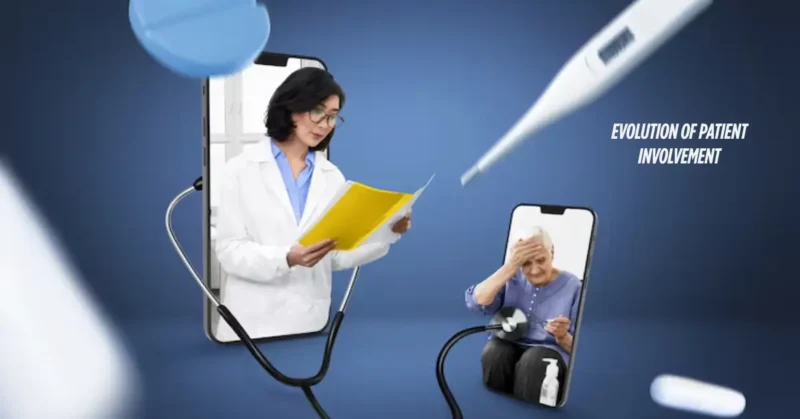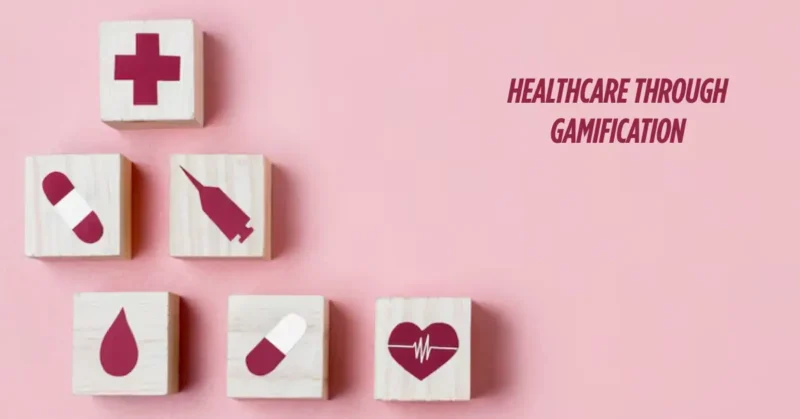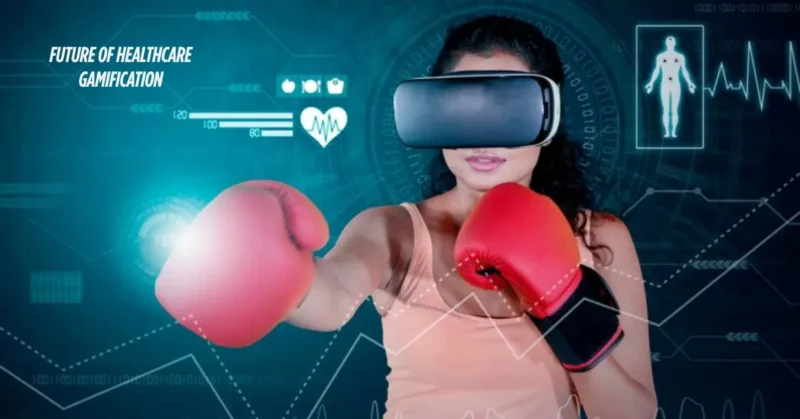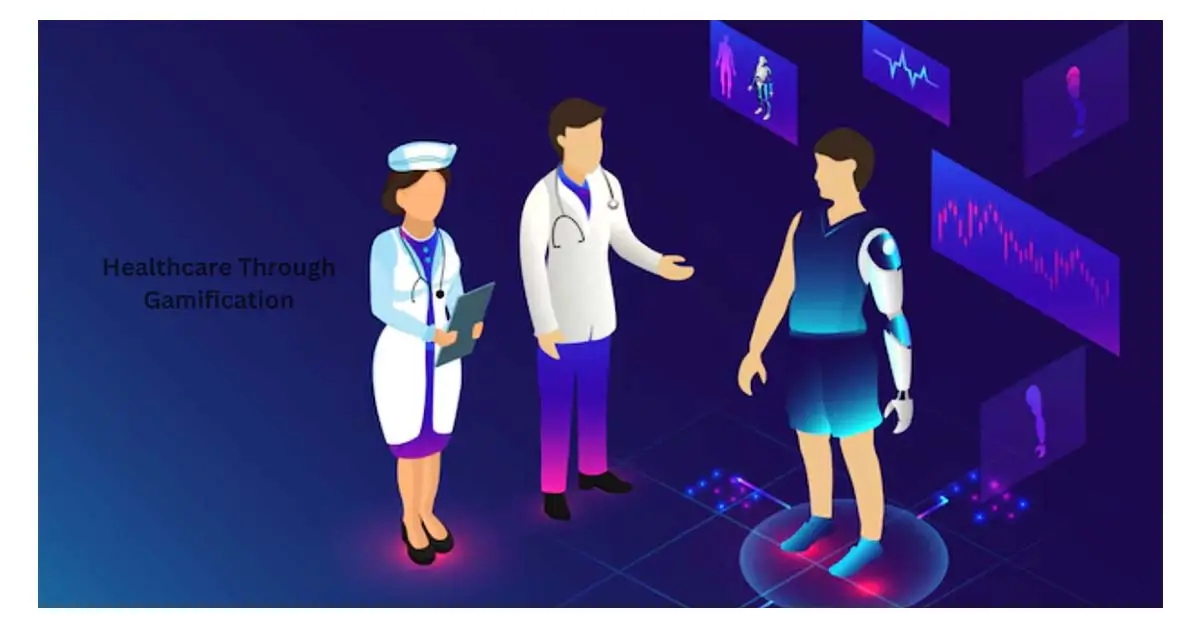Understand how gamification boosts customer engagement and retention, and explore methods to enhance patient participation in healthcare.
Thank you for reading this post, don't forget to subscribe!Healthcare Through Gamification: The Evolution of Patient Involvement
In the ever-evolving landscape of healthcare, patient engagement has emerged as a crucial focus for improving outcomes and enhancing the overall patient experience. Among the innovative strategies gaining traction is healthcare gamification—a dynamic approach that integrates gaming elements into the healthcare environment. This method not only enhances patient participation but also transforms the often daunting and sterile processes of medical care into something more interactive, enjoyable, and ultimately more effective.
Healthcare gamification involves incorporating elements such as point scoring, competitions, reward systems, and progress tracking, effectively transforming healthcare tasks into engaging activities. For instance, mobile health applications may utilize gamified features to encourage patients to adhere to their medication schedules or participate in wellness challenges, thereby fostering a sense of community and motivation.
The significance of gamification lies in its ability to increase awareness and education about health-related issues, promote healthier behaviors, and foster stronger relationships between patients and healthcare providers. By making healthcare more interactive, patients are more likely to take ownership of their health, leading to improved compliance with treatment plans and better health outcomes.
This blog post will delve deeper into the principles behind healthcare gamification, its benefits, and real-world examples that illustrate its potential to revolutionize patient engagement and reshape the future of healthcare. By examining successful implementations and the research that supports this approach, we can gain valuable insights into how gamification can bridge the gap between patient needs and healthcare services, ultimately leading to a more informed and engaged patient population.

What is healthcare gamification?
Healthcare gamification integrates game elements, such as points, rewards, competition, and challenges, into healthcare-related activities and processes. It uses the human inclination for play and competition to motivate patients to participate actively in their care. By making healthcare more interactive and engaging, gamification aims to improve patient outcomes and overall well-being.
Why is healthcare gamification meaningful?
Patient engagement is a crucial factor in achieving better healthcare outcomes. Engaged patients are more likely to adhere to treatment plans, manage chronic conditions, and take a proactive role in their health. Healthcare gamification addresses this challenge by transforming mundane medical tasks into enjoyable activities, ultimately empowering patients to take control of their health.
How can healthcare gamification improve patient engagement?
Healthcare gamification works by incorporating game elements and principles into various aspects of healthcare, from medication adherence to lifestyle modifications. These elements can include:
- Rewards and incentives: Patients can earn points, badges, or virtual rewards for completing tasks or achieving health-related goals.
- Competition: Healthy peer competition can motivate patients to strive for better health outcomes.
- Progress tracking: Visualizing their progress through graphs or charts makes patients more aware of their health status and motivates them to improve.
- Feedback and communication: Games provide a channel for patients to receive feedback and communicate with healthcare providers or fellow patients.
Benefits of healthcare gamification:
(for patients, providers, and payers)
Healthcare gamification has revolutionized the way the industry delivers and engages with care. Patients, providers, and payers reap many benefits by integrating game mechanics into healthcare systems and processes. Here’s how gamification is creating a win-win scenario for all stakeholders:
How healthcare gamification works
Common game elements used in healthcare gamification
- Points and rewards: Patients earn points or rewards for completing tasks, reaching milestones, or adhering to treatment plans.
- Challenges: Patients engage in challenges that promote healthier behaviors, such as maintaining a certain level of physical activity.
- Leaderboards: Friendly competition can be encouraged through leaderboards that show how patients compare with their peers.
Examples of successful healthcare gamification programs
- Pokémon Go: This popular augmented reality game encourages physical activity by motivating players to explore their surroundings to catch virtual creatures.
- MyFitnessPal: This app combines goal setting, tracking, and a supportive community to help users achieve their fitness and weight loss goals.
- Fitbit: Wearable fitness trackers like Fitbit use gamification to encourage users to meet daily step goals and improve their overall health.
Section 1: Benefits for Patients: A Path to Improved Health Outcomes

- Increased Engagement: Gamification keeps patients engaged with their health routines. Interactive challenges, rewards, and leaderboards motivate them to stick to treatment plans, exercise routines, or dietary guidelines.
- Enhanced Adherence: Gamified reminders and milestone tracking encourage patients to take medications, attend follow-ups, or complete rehabilitation exercises. It improves adherence and fosters better health outcomes.
- Improved Learning: Turning complex medical concepts into games or quizzes helps patients better understand their conditions and treatments. This knowledge empowers them to make informed health decisions.
- Stress Reduction and Mental Wellbeing: Fun and interactive games can alleviate stress, anxiety, and depression. Many mental health apps use gamified techniques to improve users’ moods and coping mechanisms.
- Personalized Experience: Many gamified platforms are tailored to individual needs. Patients feel more connected to their care plans, fostering a sense of ownership and responsibility.
Section 2: Benefits for Healthcare Providers: Streamlining Efficiency and Quality of Care
- Improved Patient Monitoring: Gamification tools provide real-time data on patient progress. It allows providers to monitor patients remotely and intervene proactively when necessary.
- Enhanced Communication: Interactive platforms promote better communication between providers and patients. Gamified feedback systems enable patients to share progress, concerns, or queries seamlessly.
- Increased Patient Compliance: Gamification reduces the burden of non-compliance on providers. When patients are motivated to follow through with treatments, providers can focus more on care quality rather than corrective measures.
- Simplified Training for Staff: Gamified modules make staff training more effective. Through engaging, game-like simulations, providers can quickly learn new procedures, protocols, or technologies.
- Higher Satisfaction Scores: A more engaged and satisfied patient population reflects positively on providers, boosting their satisfaction metrics and overall reputation.
Section 3: Benefits for Payers: Driving Value and Reducing Costs
- Cost Savings Through Prevention: Gamified wellness programs encourage healthier lifestyles, reducing the incidence of chronic diseases and costly interventions.
- Increased Member Engagement: Payers use gamification to keep members engaged with their health plans. Points, badges, or discounts for completing health assessments foster loyalty and active participation.
- Improved Risk Management: Real-time data from gamified systems helps payers assess health risks and intervene early. It reduces expensive claims and ensures long-term sustainability.
- Enhanced Customer Satisfaction: Interactive health management tools improve the customer experience, making health plans more appealing and user-friendly.
- Better Insights Through Data: Gamified platforms generate valuable data. Payers can analyze trends, improve plan offerings, and create personalized incentives that align with user needs.
5 Stages of Patient Engagement
Patient engagement is a critical component of modern healthcare, empowering individuals to take an active role in their health and well-being. The Patient Engagement Framework outlines five stages designed to guide and support patients on their journey toward better health. Let’s delve into these stages and understand how they empower patients.

Stage 1: Inform Me
Starting point for engagement
Patients seek information about their health, conditions, or treatment options at this initial stage. They rely on healthcare providers, online resources, and educational materials to gain knowledge. The primary goal is to ensure that patients are well-informed about their healthcare choices. Key tools and resources for this stage include:
- Brochures and pamphlets: Educational materials that explain medical conditions, treatments, and preventive measures.
- Websites and online health portals: Reliable online sources that provide easy access to health information.
- Healthcare providers: A crucial source of personalized information, guidance, and answers to questions.
Stage 2: Engage Me
Involving patients actively in their care
Patients move from passive information recipients to active healthcare participants in this stage. They seek to understand their conditions and make informed decisions. Key tools and resources for this stage include:
- Health apps and wearables: Tools that help patients monitor their health metrics and progress.
- Patient support groups: Communities that offer emotional support and shared experiences.
- Telehealth and patient portals: Technologies that allow patients to communicate with their healthcare providers and access their medical records.
Stage 3: Empower Me
Fostering confidence and self-management
Empowering patients involves helping them take control of their health and manage their conditions effectively. Patients in this stage aim to improve their self-efficacy and independence. Key tools and resources for this stage include:
- Health coaching: Personalized guidance to help patients set and achieve health goals.
- Chronic disease management programs: Support for individuals with long-term health conditions.
- Online resources for self-management: Digital tools and educational materials for disease self-care.
Stage 4: Partner with Me
This collaborative stage involves a deeper relationship between patients and healthcare teams. Instead of being passive recipients, patients become active partners in their care. They may participate in care planning, contribute to goal-setting, and even co-design elements of their treatment. Trust, communication, and mutual respect are essential here to foster long-term engagement and improved outcomes.
Stage 5: Support My E-Community
Fostering a network of support
In the final stage, patients expand their engagement beyond the healthcare provider’s office. They seek connections with their broader community, including family, friends, and others with similar health concerns. Key tools and resources for this stage include:
- Social media groups: Online platforms where patients can connect with others with similar health experiences.
- Community events: Support groups and health-related gatherings.
- Patient advocacy organizations: Groups that provide support and resources to individuals with specific health conditions.
The Future of Healthcare Gamification
Healthcare gamification is more than just a trend—it’s a transformative approach that benefits patients, providers, and payers alike. It bridges the gap between technology and human-centric care by fostering engagement, improving outcomes, and driving cost-efficiency. Embracing gamification isn’t just an option; building a healthier and more connected world is necessary.

- The Role of Technology: Get excited about the future of healthcare gamification, which involves innovative technologies such as VR, AR, and AI! Let me know if you need any further assistance. These cutting-edge advancements will undoubtedly bring us closer to achieving optimal health.VR and AR can create immersive health experiences, while AI can personalize gamified healthcare solutions for individuals.
- Up-and-Coming Innovations in Healthcare Gamification: Healthcare innovations will focus on more interactive and personalized approaches. Wearables, smart devices, and mobile apps will significantly monitor health and deliver gamified interventions.
- Anticipated Trends and Predictions for Healthcare Gamification: The future will likely see the integration of gamification into telemedicine, mental health support, and chronic disease management. Predictions suggest that healthcare gamification will continue to improve patient engagement, reduce costs, and enhance overall health outcomes.
FAQs: Healthcare Gamification
Q. What is healthcare gamification?
Healthcare gamification integrates game-like elements into healthcare-related activities and processes, such as points, rewards, friendly competition, and challenges. This approach is designed to transform traditional healthcare experiences by making them more interactive and enjoyable for patients.
By leveraging principles commonly found in gaming, such as achievement tracking and social interaction, healthcare gamification aims to motivate patients to take a more active role in managing their health. For instance, patients may earn points for completing tasks like attending medical appointments, following prescribed exercise regimens, or adhering to medication schedules. These points can often be redeemed for rewards, creating a tangible incentive to engage consistently with their health.
Additionally, gamification can foster a sense of community among patients, as they can compete with friends or other participants to reach health goals, share progress, or overcome challenges together. This collaborative and competitive spirit can lead to improved health outcomes and greater overall satisfaction with the healthcare experience. By making health management feel less like a chore and more like an engaging activity, healthcare gamification seeks to enhance patient engagement and ultimately lead to better health results.
Q. How can healthcare gamification benefit patients?
Healthcare gamification offers patients a wide array of benefits, ultimately transforming their experience with health management. One key advantage is that it significantly enhances motivation and adherence to treatment plans. By incorporating game-like elements such as rewards, challenges, and interactive features, patients are more likely to engage with prescribed therapies and follow recommended guidelines.
Moreover, gamification can improve health outcomes by fostering a sense of achievement and progress. When patients track their health metrics through engaging platforms, they can see tangible results, inspiring them to maintain healthier habits over time.
Additionally, gamification can help reduce stress and anxiety associated with managing health conditions. By making the process more playful and less intimidating, patients may feel more relaxed and less overwhelmed, which can contribute positively to their overall well-being.
Lastly, gamification empowers patients by boosting their self-efficacy. When individuals are actively involved in their health journeys—setting goals, earning rewards, and overcoming challenges—they cultivate a greater sense of control over their health. This empowerment encourages them to take a proactive stance toward their wellness, ultimately leading to a more fulfilling and health-oriented lifestyle.
Q. How can healthcare gamification benefit healthcare providers?
Healthcare gamification has the potential to significantly enhance patient engagement and satisfaction, providing valuable benefits for healthcare providers. By incorporating game-like elements into healthcare processes, providers can create a more interactive and enjoyable patient experience, encouraging them to take a more active role in their health management.
Additionally, gamification can lead to increased efficiency and productivity within healthcare settings. With access to real-time data and insights into patient behavior, healthcare providers can better understand individual patient needs and preferences.
This data-driven approach allows for the development of more personalized treatment plans and interventions, ultimately leading to improved health outcomes. By motivating patients through rewards and challenges, gamification enhances their experience and encourages adherence to treatment protocols and healthier lifestyle choices.
Q. What benefits does healthcare gamification offer to payers?
Healthcare gamification offers significant advantages for payers by helping to reduce overall healthcare costs. When patients actively engage in their health management through gamified systems, they are less likely to require expensive medical interventions, emergency room visits, or hospital readmissions. This proactive engagement encourages healthier lifestyle choices, improving patient compliance with treatment plans and medication schedules.
In addition to reducing the need for costly medical services, healthcare gamification can enhance population health outcomes. By fostering a culture of wellness and prevention, gamified tools can help identify at-risk individuals early, enabling timely interventions that prevent the escalation of health problems. This approach ultimately alleviates the strain on the healthcare system as a whole.
Furthermore, when patients experience increased satisfaction from their involvement in these gamified programs, it can lead to greater loyalty and retention rates for payers. Satisfied patients are likelier to stay with their insurance plans and recommend them to others, contributing to a more stable and rewarding business environment for payers. Overall, the strategic implementation of gamification in healthcare can create a win-win scenario for patients and payers.
Q. Can you provide examples of successful healthcare gamification programs?
Some examples of successful healthcare gamification programs:
- Pokémon Go: This game encourages physical activity and exploration by getting players to walk around in real-world locations to find Pokémon.
- MyFitnessPal: This app combines goal setting and tracking, helping users achieve fitness and weight loss goals.
- Fitbit: This wearable fitness tracker incorporates gamification elements to motivate users to meet daily step goals and improve their overall health.
These programs effectively integrate game mechanics to promote healthier behaviors.
Q. How do you implement a successful healthcare gamification program?
To implement a successful healthcare gamification program, it’s important to:
- Understand your audience: Tailor the gamification elements to your patient population’s specific needs and preferences.
- Integrate with existing systems: Ensure your gamification program seamlessly integrates with electronic health records and other healthcare systems.
- Educate and train: Provide patients and healthcare providers with training on how to use gamification tools effectively.
- Collect and analyze data: Continuously collect and analyze data to refine your gamification program and improve patient engagement.
Q. What resources are available for more information on healthcare gamification?
For more information on healthcare gamification, you can explore the following resources:
- Gamify Health
- Healthcare IT News – Gamification
- Forbes – How Gamification is Reshaping Corporate Wellness Programs
The Bottom Line
We cover gamification in customer interactions and patient engagement. Integrating game elements into brand interactions can boost customer engagement and retention.
- Learn how gamification can revolutionize your approach.
- Gain insights on the four pillars of patient engagement: inform, engage, empower, and collaborate with patients.
- Discover effective patient engagement strategies to boost healthcare outcomes.
- Explore the ultimate guide to enhancing engagement in both customer relations and healthcare.
- Unlock the secrets to building solid connections and improving outcomes with this invaluable resource.
Read more articles on Health and Wellness.
You may like to read these articles:

